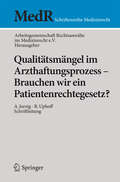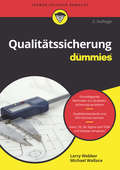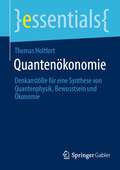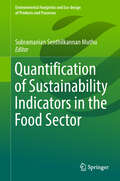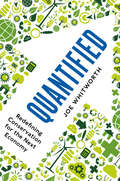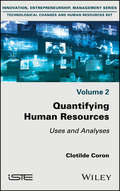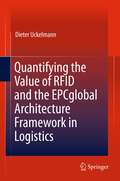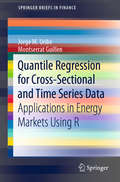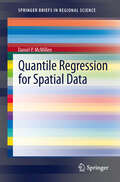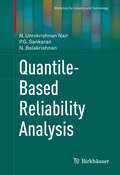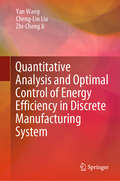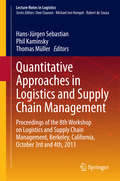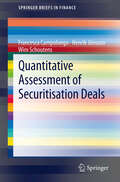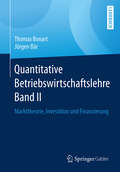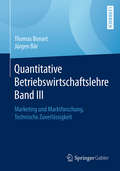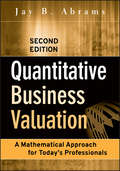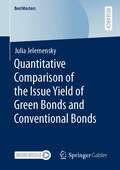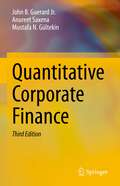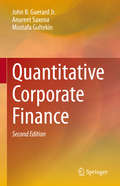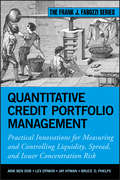- Table View
- List View
Qualitätsmängel im Arzthaftungsprozess - Brauchen wir ein Patientenrechtegesetz? (MedR Schriftenreihe Medizinrecht)
by ArbeitsgemeinschaftNach ca. 20-jähriger Diskussion soll nunmehr auf Bundesebene ein Patientenrechtegesetz verabschiedet werden. Mit dem Gesetz wird das Ziel verfolgt, Transparenz über die Rechte der Patientinnen und Patienten herzustellen, die Durchsetzung dieser Rechte zu verbessern sowie Patientinnen und Patienten im Sinne einer verbesserten Gesundheitsversorgung zu schützen und im Falle eines Behandlungsfehlers stärker zu unterstützen. Das XXIII. Kölner Symposium der Arbeitsgemeinschaft Medizinrecht formuliert Fragen und Referate, ob ein Patientenrechtegesetz wegen möglicher Qualitätsmängel im Arzthaftungsprozess notwendig ist und ob das diskutierte Patientenrechtegesetz tatsächlich dem Anspruch gerecht wird, diese Patientenrechte zu stärken. Ist die Rechtsposition des Patienten ausreichend, wenn es um die Anhörung des Sachverständigen geht? Sind Neuregelungen über die Aufklärungspflicht des Arztes erforderlich oder genügt die Rechtsprechung zur Aufklärung, um das Selbstbestimmungsrecht des Patienten sicherzustellen? Die Beiträge behandeln sowohl materiell-rechtliche als auch zivilprozessuale Rechtsfragen, die das Arzt- und Patientenverhältnis im Arzthaftungsprozess betreffen. Auch wenn im Ergebnis wohl festgestellt werden muss, dass das diskutierte Patientenrechtegesetz einen "Mangel an legislativer Eigenständigkeit" (Prof. Dr. Dieter Hart, Universität Bremen) belegt, so wird die Diskussion um die Patientenrechte speziell im Arzthaftungsprozess anhalten.
Qualitätssicherung für Dummies (Für Dummies)
by Michael Wallace Larry Webber"Qualitätssicherung für Dummies" führt Sie in die Grundlagen des Qualitätsmanagements ein und zeigt, wie Sie durch strukturiertes, systematisches Vorgehen die operative Umsetzung des Qualitätsmanagements unterstützen. Die Autoren Larry Webber und Michael Wallace definieren zunächst den Begriff "Qualität", erklären die Bedeutung von Qualitätsstandards und wie sich diese auf die Produkte und Strategien in einem Unternehmen auswirken. Anhand von vielen Methoden und Instrumenten wie Six Sigma, Kanban, Kaizen, Lean, 5S und der Meinung der Kunden erfahren Sie, wie Sie Prozessqualität messen können und bei der Umsetzung dieses Systems die Mitarbeiter nicht außen vor lassen.
Quantenökonomie: Denkanstöße für eine Synthese von Quantenphysik, Bewusstsein und Ökonomie (essentials)
by Thomas HoltfortDieses Buch beschäftigt sich mit dem neuen Begriff der „Quantenökonomie“. Diese verbindet Erkenntnisse aus der Quantenphysik und der Bewusstseinsforschung mit ökonomischen Prozessen bzw. Rahmenbedingungen und versucht mit dem Quantenbewusstseinsmodell einen neuen Realitätsbegriff zu schaffen. Dieser Realitätsbegriff generiert neue Ideen und Denkanstöße für einen methodologisch anderen Ökonomiebegriff mit dem Ziel, das Potenzial für sinnvollere und nachhaltigere Entscheidungen zu erweitern.
Quantification of Structural Liquidity Risk in Banks (BestMasters)
by Christoph WieserStructural liquidity risk is a material risk resulting from the core banking business of taking in short-term deposits and lending out long-term loans, thus allowing a maturity mismatch between assets and liabilities. At some point the long-term loans will require refinancing and the institution is at risk of an adverse development of refinancing costs.This book proposes a model for the quantification of structural liquidity risk and describes the underlying methodology and assumptions for stressing the refinancing costs. The change in present value between closing open liquidity positions under stressed refinancing costs compared to current costs is the calculated impact on risk-bearing capacity.
Quantification of Sustainability Indicators in the Food Sector (Environmental Footprints And Eco-design Of Products And Processes)
by Subramanian Senthilkannan MuthuThis book highlights various methods of quantifying sustainability indicators in the food sector, highlighting the environmental indicators in the meat chain and agri-food wastes from a bio-refinery perspective. Numerous sustainability indicators that encompass all three pillars – economic, environmental and social areas – as well as individual and joint indicators (e.g. environmental and social) have been developed and quantified to date. Some of these indicators can be utilised for any industrial sector, while others are sector-specific. Behind each indicator developed, there is a unique scientific model, method or assessment technique. This book enumerates these indicators, providing details such as the concept, development methodology, assessment technique, and applications, mainly in the food industry.
Quantified
by Joe WhitworthGoogle, Apple, Amazon, Uber: companies like these have come to embody innovation, efficiency, and success. How often is the environmental movement characterized in the same terms? Sadly, conservation is frequently seen as a losing battle, waged by well-meaning, but ultimately ineffective idealists. Joe Whitworth argues it doesn't have to be this way. In fact, it can't be this way if we are to maintain our economy, let alone our health or the planet's. In Quantified, Whitworth draws lessons from the world's most tech-savvy, high-impact organizations to show how we can make real gains for the environment. The principles of his approach, dubbed quantified conservation, will be familiar to any thriving entrepreneur: situational awareness, bold outcomes, innovation and technology, data and analytics, and gain-focused investment. This no-nonsense strategy builds on the inspirational environmental work begun in the 1970s, while recognizing that the next economy will demand new solutions. As President of The Freshwater Trust, Whitworth has put quantified conservation into practice, pioneering the model of a "do-tank" that is dramatically changing how rivers can get restored across the United States. The stories in Quantified highlight the most precious of resources--water--but they apply to any environmental effort. Whether in the realm of policy, agriculture, business, or philanthropy, Whitworth is charting a new course for conservation.
Quantifying Human Resources: Uses and Analyses
by Clotilde CoronSince the late 20th Century, Human Resources (HR) has had a legal obligation to produce reports for management in most firms. However, these have long been considered restrictive and are seldom used to improve decision-making. More recently, the emergence of analytics, Big Data and algorithms has enabled a reconfiguration of the uses of quantification in HR. Accompanied by empirical examples, this book presents and defines the different tools and uses of quantification in HR. It studies the effect of these tools on decision-making and ? without subscribing to the myth of objective and rational quantification ? presents the contributions and limits of the use of data in HR, and analyzes the potential risks of excessive quantification. It also discusses the appropriation of these tools by the various players in a company and examines their effects on the position of HR.
Quantifying the Value of RFID and the EPCglobal Architecture Framework in Logistics
by Dieter UckelmannThe "EPCglobal Architecture Framework" is currently the most accepted technical approach to the Internet of Things and provides a solid foundation for building Business-to-Business information networks based on unique identifications of 'things'. Lately, the vision of the Internet of Things has been extended to a more holistic approach that integrates sensors as well as actuators and includes non-business stakeholders. A detailed look at the current state of the art in research concerning cost and benefit estimations is provided and the limits of Cost Benefit Sharing for RFID-based IT-infrastructures are explained. In this work a market driven evaluation based on sales potential of information is developed. Simple technical means for aggregation of micro values to a billable amount are discussed. The requirements for electronic billing infrastructure are defined and a matching e-billing solutions for an evaluation scenario is presented, providing a technical infrastructure to evaluate and bill product-related information in a future Internet of Things, based on an extended EPCglobal Architecture. Further opportunities and threats are discussed to provide an overview of its future potential. As a result it will contribute to the sustainable success of the Internet of Things itself.
Quantile Regression
by Roger KoenkerQuantile regression is gradually emerging as a unified statistical methodology for estimating models of conditional quantile functions. By complementing the exclusive focus of classical least squares regression on the conditional mean, quantile regression offers a systematic strategy for examining how covariates influence the location, scale and shape of the entire response distribution. This monograph is the first comprehensive treatment of the subject, encompassing models that are linear and nonlinear, parametric and nonparametric. The author has devoted more than 25 years of research to this topic. The methods in the analysis are illustrated with a variety of applications from economics, biology, ecology and finance. The treatment will find its core audiences in econometrics, statistics, and applied mathematics in addition to the disciplines cited above.
Quantile Regression for Cross-Sectional and Time Series Data: Applications in Energy Markets Using R (SpringerBriefs in Finance)
by Jorge M. Uribe Montserrat GuillenThis brief addresses the estimation of quantile regression models from a practical perspective, which will support researchers who need to use conditional quantile regression to measure economic relationships among a set of variables. It will also benefit students using the methodology for the first time, and practitioners at private or public organizations who are interested in modeling different fragments of the conditional distribution of a given variable. The book pursues a practical approach with reference to energy markets, helping readers learn the main features of the technique more quickly. Emphasis is placed on the implementation details and the correct interpretation of the quantile regression coefficients rather than on the technicalities of the method, unlike the approach used in the majority of the literature. All applications are illustrated with R.
Quantile Regression for Spatial Data
by Daniel P. McmillenQuantile regression analysis differs from more conventional regression models in its emphasis on distributions. Whereas standard regression procedures show how the expected value of the dependent variable responds to a change in an explanatory variable, quantile regressions imply predicted changes for the entire distribution of the dependent variable. Despite its advantages, quantile regression is still not commonly used in the analysis of spatial data. The objective of this book is to make quantile regression procedures more accessible for researchers working with spatial data sets. The emphasis is on interpretation of quantile regression results. A series of examples using both simulated and actual data sets shows how readily seemingly complex quantile regression results can be interpreted with sets of well-constructed graphs. Both parametric and nonparametric versions of spatial models are considered in detail.
Quantile-Based Reliability Analysis
by N. Balakrishnan P. G. Sankaran N. Unnikrishnan NairThis book provides a fresh approach to reliability theory, an area that has gained increasing relevance in fields from statistics and engineering to demography and insurance. Its innovative use of quantile functions gives an analysis of lifetime data that is generally simpler, more robust, and more accurate than the traditional methods, and opens the door for further research in a wide variety of fields involving statistical analysis. In addition, the book can be used to good effect in the classroom as a text for advanced undergraduate and graduate courses in Reliability and Statistics.
Quantitative Analysis and Optimal Control of Energy Efficiency in Discrete Manufacturing System
by Yan Wang Cheng-Lin Liu Zhi-Cheng JiThis book provides energy efficiency quantitative analysis and optimal methods for discrete manufacturing systems from the perspective of global optimization. In order to analyze and optimize energy efficiency for discrete manufacturing systems, it uses real-time access to energy consumption information and models of the energy consumption, and constructs an energy efficiency quantitative index system. Based on the rough set and analytic hierarchy process, it also proposes a principal component quantitative analysis and a combined energy efficiency quantitative analysis. In turn, the book addresses the design and development of quantitative analysis systems. To save energy consumption on the basis of energy efficiency analysis, it presents several optimal control strategies, including one for single-machine equipment, an integrated approach based on RWA-MOPSO, and one for production energy efficiency based on a teaching and learning optimal algorithm. Given its scope, the book offers a valuable guide for students, teachers, engineers and researchers in the field of discrete manufacturing systems.
Quantitative Approaches in Logistics and Supply Chain Management
by Thomas Müller Hans-Jürgen Sebastian Phil KaminskyThis contributed volume presents selected research papers from the 8th workshop on Logistics and Supply Chain Management, which was held in October 2013 in Berkeley, California. It focuses on the topical issue of quantitative approaches in logistics and supply chain management, mainly covering facility location and location routing; vehicle routing and scheduling; courier, express and parcel service network design; healthcare logistics as well as logistics risk management. The target audience primarily comprises research experts and practitioners in the field, but the book will also be beneficial to graduate students.
Quantitative Assessment of Securitisation Deals
by Wim Schoutens Henrik Jönsson Francesca CampolongoThe book draws on current research on model risk and parameter sensitivity of securitisation ratings. It provides practical ideas and tools that can facilitate a more informed usage of securitisation ratings. We show how global sensitivity analysis techniques can be used to better analyse and to enhance the understanding of the uncertainties inherent in ratings due to uncertainty in the input parameters. The text introduces a novel global rating approach that takes the uncertainty in the ratings into account when assigning ratings to securitisation products. The book also covers new prepayment and default models that overcome flaws in current models.
Quantitative Betriebswirtschaftslehre Band II: Markttheorie, Investition und Finanzierung
by Thomas Bonart Jürgen BärDas dreibändige Lehrbuch „Quantitative BWL“ stellt die theoretischen quantitativen Grundlagen der betrieblichen Entscheidungen und des marktwirtschaftlichen Umfelds dar. Es ist für Studierende der Wirtschaftswissenschaften und des Wirtschaftsingenieurwesens im Bachelor- und Masterprogramm konzipiert. Auch komplexe Inhalte werden durch zahlreiche Beispiele verständlich und anschaulich erklärt. Zu jedem Kapitel gibt es Übungsaufgaben mit Lösungshinweisen. Somit eignet sich das Lehrbuch zur Unterstützung von Vorlesungen, aber auch zum autodidaktischen Lernen.
Quantitative Betriebswirtschaftslehre Band III: Marketing und Marktforschung, Technische Zuverlässigkeit
by Thomas Bonart Jürgen BärDas dreibändige Lehrbuch „Quantitative BWL“ stellt die theoretischen quantitativen Grundlagen der betrieblichen Entscheidungen und des marktwirtschaftlichen Umfelds dar. Es ist für Studierende der Wirtschaftswissenschaften und des Wirtschaftsingenieurwesens im Bachelor- und Masterprogramm konzipiert. Auch komplexe Inhalte werden durch zahlreiche Beispiele verständlich und anschaulich erklärt. Zu jedem Kapitel gibt es Übungsaufgaben mit Lösungshinweisen. Somit eignet sich das Lehrbuch zur Unterstützung von Vorlesungen, aber auch zum autodidaktischen Lernen.
Quantitative Business Valuation
by Jay B. AbramsPraise for the First Edition of Quantitative Business ValuationA Mathematical Approach for Today's Professionals"Jay Abrams' book is close to the equivalent of several graduate dissertations rolled into one book. For each topic (covered), he presents a scholarly summary of past research, new empirical research of his own, and his conclusions. It is a well-documented contribution to in-depth understanding of important business valuation issues, and should not be overlooked by the serious practitioner."--Shannon Pratt, DBAManaging Director, Willamette Management AssociatesCoauthor, Valuing a Business"A must-read for the serious business appraiser."--Jay E. Fishman, ASA, CBAPresident, Financial Research, Inc."The problem of simplified valuation procedures and coherent theory still remains complex and is ever evolving. Jay Abrams deals very effectively with this complexity through the use of mathematical formulas. Input to his models is explained with clarity and effectiveness, which adds to the overall value of this advanced text on business valuation."--Terry A. Isom, Chairman, National Association of Certified Valuation Analysts"Jay Abrams' book strives to provide mathematical modeling for what practitioners often do by reasoning alone. This book is a must-read for practitioners who are searching for additional techniques for dealing with some of business valuation's imponderables."--David M. Bishop, FIBA, BVAL, ASA, MCBAPresident, American Business Appraisers, Inc."Jay Abrams' book will not only challenge the top theoreticians in the field; his step-by-step explanations will make advanced quantitative techniques available to the many appraisers who are not capable of independently creating the underlying mathematical analysis."--Kent Osborne, ASAChairman, Editorial Review Board of the American Society of Appraisers"While a proliferation of business valuation treatises and guides exists in the market, most are very general in nature and do nothing more than rehash fundamental concepts. I am unaware of any author who has stepped into the unknown as Jay Abrams has and compiled and developed a treatise of extremely useful analytical tools for the serious valuator."--Robert J. Grossman, CPA/ABV, ASA, CVAPartner, Grossman Yanak & Ford"Jay Abrams develops unusual approaches which merit consideration when 'cookie cutter' methodologies are inadequate. This manuscript contributes to the dialogue among practitioners and strengthens the theoretical foundations of business valuation."--Herbert T. SpiroPresident, American Valuation Group, Inc."There is no question about it, the use of rigorous quantitative methods is the cure for subjective valuation analysis. This book not only satisfies this need--which has grown considerably in recent years--but is chock-full of new tools that have been carefully developed."--Edward MurrayValuation Partner, Arthur Andersen, LLP
Quantitative Comparison of the Issue Yield of Green Bonds and Conventional Bonds (BestMasters)
by Julia JelemenskyDue to the novelty of green bonds in the fixed income area, little empirical research has been done on the question which impact the fact that a bond is investing in green projects has on the yield that investors receive. The aim of this book is to determine if there is a discount or premium on the yield at issuance of green bonds. The analysis is mainly based on an empirical study. The author examined the influence of eight selected indicators on the issue yield of bonds using a multivariate regression analysis. The analyzed sample comprised data sets of 601 bonds.
Quantitative Corporate Finance
by John B. Guerard Jr. Anureet Saxena Mustafa N. GültekinThis textbook presents a comprehensive treatment of the legal arrangement of the corporation, the instruments and institutions through which capital can be raised, the management of the flow of funds through the individual firm, and the methods of dividing the risks and returns among the various contributors of funds.Now in its third edition, the book covers a wide range of topics in corporate finance, from time series modeling and regression analysis to multi-factor risk models and the Capital Asset Pricing Model. Guerard, Gultekin and Saxena build significantly on the first edition of the text, but retain the core chapters on cornerstone topics such as mergers and acquisitions, regulatory environments, bankruptcy and various other foundational concepts of corporate finance.New to the third edition are examinations of APT portfolio selection and time series modeling and forecasting through SAS, SCA and OxMetrics programming, FactSet fundamental data templates. This is intended to be a graduate-level textbook, and could be used as a primary text in upper level MBA and Financial Engineering courses, as well as a supplementary text for graduate courses in financial data analysis and financial investments.
Quantitative Corporate Finance
by John B. Guerard Jr. Anureet Saxena Mustafa GultekinThis textbook presents a comprehensive treatment of the legal arrangement of the corporation, the instruments and institutions through which capital can be raised, the management of the flow of funds through the individual firm, and the methods of dividing the risks and returns among the various contributors of funds.Now in its second edition, the book covers a wide range of topics in corporate finance, from time series modeling and regression analysis to multi-factor risk models and the Capital Asset Pricing Model. Guerard, Gultekin and Saxena build significantly on the first edition of the text, but retain the core chapters on cornerstone topics such as mergers and acquisitions, regulatory environments, bankruptcy and various other foundational concepts of corporate finance.New to the second edition are examinations of APT portfolio selection and time series modeling and forecasting through SAS, SCA and OxMetrics programming, FactSet fundamental data templates. This is intended to be a graduate-level textbook, and could be used as a primary text in upper level MBA and Financial Engineering courses, as well as a supplementary text for graduate courses in financial data analysis and financial investments.
Quantitative Credit Portfolio Management
by Arik Ben Dor Lev Dynkin Jay Hyman Bruce D. PhelpsAn innovative approach to post-crash credit portfolio management Credit portfolio managers traditionally rely on fundamental research for decisions on issuer selection and sector rotation. Quantitative researchers tend to use more mathematical techniques for pricing models and to quantify credit risk and relative value. The information found here bridges these two approaches. In an intuitive and readable style, this book illustrates how quantitative techniques can help address specific questions facing today's credit managers and risk analysts. A targeted volume in the area of credit, this reliable resource contains some of the most recent and original research in this field, which addresses among other things important questions raised by the credit crisis of 2008-2009. Divided into two comprehensive parts, Quantitative Credit Portfolio Management offers essential insights into understanding the risks of corporate bonds--spread, liquidity, and Treasury yield curve risk--as well as managing corporate bond portfolios. Presents comprehensive coverage of everything from duration time spread and liquidity cost scores to capturing the credit spread premium Written by the number one ranked quantitative research group for four consecutive years by Institutional Investor Provides practical answers to difficult question, including: What diversification guidelines should you adopt to protect portfolios from issuer-specific risk? Are you well-advised to sell securities downgraded below investment grade? Credit portfolio management continues to evolve, but with this book as your guide, you can gain a solid understanding of how to manage complex portfolios under dynamic events.
